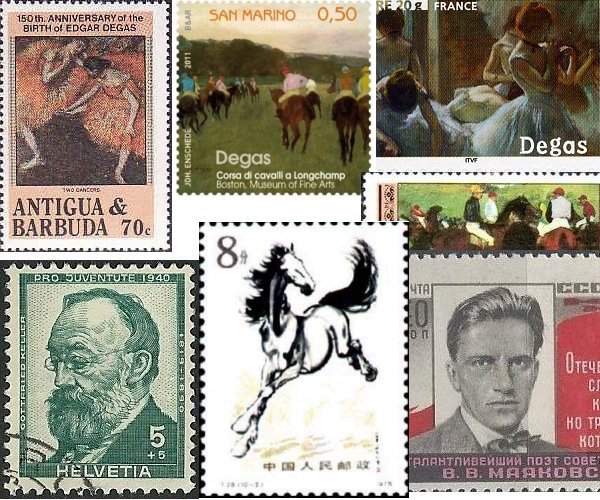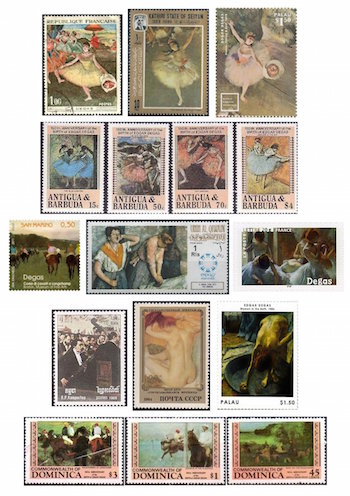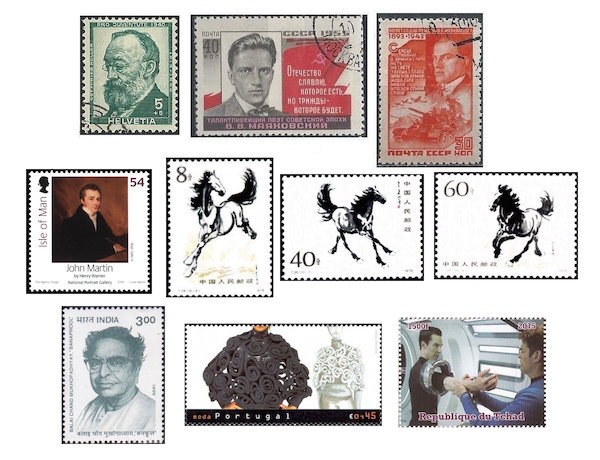The Arts on Stamps of the World — July 19
An Arts Fuse regular feature: the arts on stamps of the world.

By Doug Briscoe
The day belongs to Edgar Degas, but we also salute two important poets, Gottfried Keller and Vladimir Mayakovsky, along with English painter John Martin, Chinese painter Xu Beihong, the Bengali novelist known as Banaphul, Portuguese fashion designer Ana Salazar, and English actor Benedict Cumberbatch.
After dancers, one tends to associate Edgar Degas (19 July 1834 – 27 September 1917) more with racehorses than with any other subject. So I begin the collage with the ballet and conclude with horses. In between we have The Ironers (c1884), at center, on a stamp from Umm al Qiwain, The Orchestra of the Opera (1869) on one from Cambodia, La Toilette (Woman Combing Her Hair, c1884–86) on a Soviet one, and Woman in the Bath (1886) from Palau. I would also draw your attention to the San Marino stamp at center left: it is of Racehorses at Longchamp (1871), which is housed here in Boston at the MFA. (The museum did a retrospective of the artist, “Degas and the Nude”, in 2011.) That Degas was also a sculptor one may remember from the famous Little Fourteen-Year-Old Dancer (1881), but unless you’re a student of Degas you may not know that he became keenly interested in photography beginning in the 1880s and made portraits in the new medium, including some of himself. He was also a hidebound reactionary and a virulent anti-Semite.
Swiss poet Gottfried Keller (19 July 1819 – 15 July 1890) yearned to be a painter, even studying at Munich’s Royal Academy for a time. He took up writing and published his first poems in 1846, devoting himself fully to literature after his move to Berlin in 1850. These years saw the production of his semi-autobiographical novel Der grüne Heinrich (Green Henry). (He revised the text in 1879.) His first collection of stories includes Romeo und Julia auf dem Dorfe, made into an opera by Frederick Delius under the title A Village Romeo and Juliet. As for other settings of Keller in music, there are three Lieder each by Brahms and Schoenberg, a six-song group by Hugo Wolf (Alte Weisen), Hans Pfitzner’s 8 songs, Op. 33, and many others.

Russian poet Vladimir Mayakovsky ([O.S. July 7] 1893 – 14 April 1930) was also a playwright, artist, and actor who appeared in three or four silent films. He was both a devoted Communist and warm supporter of Lenin and yet also an enfant terrible highly critical of censorship. Mayakovsky was born in Georgia to parents of Russian, Cossack, and Ukrainian ethnicity. An activist from his early teens, he was arrested and started writing poetry while imprisoned. On his release he decided to concentrate on writing. In the 20s he traveled to the west and wrote about it in books such as My Discovery of America (1925). There was for a long time considerable controversy about his death, some attributing it to murder by Soviet agents, but suicide was a recurring theme, if not an obsession, with Mayakovsky and seems now the likeliest cause. Although greatly admired for his poetry, he seems not have inspired many musical settings; Emily Ezust’s superb LiederNet Archive lists only a few pieces, one each by American composers Gerald Busby and Leonard Lehrman and French composer and organist Pierre Chépélov. The most significant work would appear to be the choral “Oratorio Pathétique” (1959) by Georgy Sviridov.
English painter John Martin (19 July 1789 – 17 February 1854) made a specialty of grand, tumultuous, often apocalyptic canvases like The Great Day of His Wrath (c1853) and The Destruction of Pompei and Herculaneum (1822). Born in Northumberland, he went to London at 17 and in 1812 discovered his forte with Sadak in Search of the Waters of Oblivion, though success with the public had to wait until 1816’s Joshua Commanding the Sun to Stand Still. Mezzotints and engravings of his works were much in demand, and he was asked to illustrate a new edition of Paradise Lost. Martin’s “big ideas” were not limited to painting—he also designed a prescient plan for a London sewage system, partly utilized after his death, and other large-scale projects. His paintings influenced such disparate figures as American landscape artist Thomas Cole, the pre-Raphaelites, and D.W. Griffith. None of Martin’s canvases is on a stamp, but in 2006 the Isle of Man issued a set of stamps honoring famous men who had visited the island at one time or another. Martin died there following a stroke.

Xu Beihong (19 July 1895 – 26 September 1953) studied Chinese calligraphy and painting from early childhood, then learned Western art in Paris from 1919, returning to China in 1927. In 1933 he organized an exhibition of Chinese art that traveled through Europe. During World War II he held similar exhibitions in Singapore and India, with the proceeds benefiting Chinese war victims. He thrived in prominent administrative positions in the new People’s Republic. The stamps shown come from a set of ten “Galloping horses” designs issued by the PRC in 1978, and those interested may see the entire set here.
The Bengali writer Balai Chand Mukhopadhyay (1899–1979) adopted the pen name Banaphul in order to keep his writing a secret from his father, a doctor. Born in Bihar in northeastern India, Mukhopadhyay himself became a pathologist but wrote prolifically, 60 novels, hundreds of short stories and poems, as well as a number of plays and essays. At least eight of his works have been adapted to film.
Fashion designers have not often been represented on postage stamps. A noteworthy exception is Oscar de la Renta, who just this year was commemorated by the USPS with a large sheet we’ll see in a few days, his birthday coming on the 22nd. For today, though, we turn to a recent Portuguese set that includes Ana Salazar (born 19 July 1941), who has been marketing her line of clothing since 1978. Her designs have been used by airline personnel and employees of the Portuguese railways and in theater and ballet productions and have expanded to include crystal vases and eyeglass frames.
When Benedict Cumberbatch (born 19 July 1976) was first coming to fame in the United States, a friend of mine jokingly referred to him as “Cummerbund Bandersnatch”. The English actor has shot to the summit of his profession with his work in Shakespearean theater as well as in popular TV (the modernized Sherlock Holmes series with Martin Freeman) and movies like Star Trek Into Darkness (2013), a still from which shows up on a Chadian stamp from two years ago.
A graduate of the University of Massachusetts with a B.A. in English, Doug Briscoe worked in Boston classical music radio, at WCRB, WGBH, and WBUR, for about 25 years, beginning in 1977. He has the curious distinction of having succeeded Robert J. Lurtsema twice, first as host of WGBH’s weekday morning classical music program in 1993, then as host of the weekend program when Robert J.’s health failed in 2000. Doug also wrote liner notes for several of the late Gunther Schuller’s GM Recordings releases as well as program notes for the Boston Classical Orchestra. For the past few years he’s been posting a Facebook “blog” of classical music on stamps of the world, which has now been expanded to encompass all the arts for The Arts Fuse.
